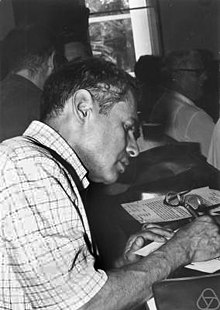Irving Segal

Irving Ezra Segal (born September 13, 1918 in the Bronx , New York City , † December 24, 1998 in Lexington , Massachusetts ) was an American mathematician who dealt with functional analysis , harmonic analysis, C * algebras and mathematical quantum field theory .
Life
Segal attended school in Trenton (New Jersey) and began to study at Princeton University in 1934 , where he made his bachelor's degree in 1937 with top grades. In 1940 he received his doctorate with Einar Hille at Yale University with the dissertation Ring Properties of Certain Classes of Functions . In 1941 he was an instructor at Harvard University , from 1941 to 1943 Research Associate at Princeton and from 1945 to 1948 at the Institute for Advanced Study at Princeton, where he worked with Albert Einstein and John von Neumann . In between, he worked in ballistics during the Second World War during his military service on the Aberdeen Proving Ground of the US Army. In 1948 he became an assistant professor at the University of Chicago , 1953 associate professor and 1957 professor. In 1960 he moved to the Massachusetts Institute of Technology (MIT), where he was a professor until his death (from 1989 as emeritus). He was visiting professor at the Sorbonne , the Collège de France, Moscow, Copenhagen, Lund, Pisa and Columbia University, among others .
Segal was a Guggenheim Fellow in 1947, 1951 and 1967. In 1981 he received the Humboldt Prize. In 1973 he was elected to the National Academy of Sciences . He was also a member of the American Academy of Arts and Sciences (since 1961) and the Royal Danish Academy of Sciences .
In functional analysis, he generalized the work of Norbert Wiener on stochastic processes in Hilbert spaces, developed a theory of non-commutative integration and thereby generalized Plancherel's theorem for locally compact groups . His name is associated with the GNS construction , where the S stands for Segal.
Segal was very interested in mathematical physics (he was not only a member of the AMS , but also the US Astronomical and Physical Society). He was the first to recognize the importance of C * algebras as observable algebras for the formulation of an axiomatic quantum field theory . As early as 1947 he used it for a mathematical reformulation of the postulates of quantum mechanics. At the beginning of the 1960s he organized two conferences at MIT - but the further development of the area in the 1960s by James Glimm and Arthur Jaffe was not to his taste.
Segal tended to be unconventional. He advocated an alternative ("chronometric") theory to explain the redshift of distant galaxies as a geometric effect (instead of as evidence of an expansion of the universe after the Big Bang), which he sought to substantiate through statistical analyzes of the astronomical spectra. The origin of his speculations lay in his 1951 research on the deformation of Lie algebras. Just as the Galileo group is a borderline case of the Lorentz group of special relativity (and this is a deformation of the Galileo group), the Lorentz group is a borderline case of the more general conformal group which, according to Segal, is the actual symmetry group of the universe.
In 1966 he was invited speaker at the ICM in Moscow (Nonlinear relativistic partial differential equations) and in 1970 in Nice (Nonlinear quantum processes and automorphism groups of C * algebras).
His students include John Baez , Isadore Singer , Edward Nelson and Bertram Kostant . He was married twice and had three children from his first marriage and a daughter from his second marriage.
Fonts
- Segal, Baez, Zhou: Introduction to Algebraic and Constructive Quantum Field Theory. Princeton 1992.
- Mathematical cosmology and extragalactic astronomy. Academic Press 1976.
- Integrals and Operators. McGraw Hill 1968, Springer-Verlag 1978.
- Mathematical Problems in Relativistic Physics. AMS 1963 (with appendix by George Mackey ).
literature
- Victor Guillemin (Ed.): Studies in applied mathematics- a volume dedicated to Irving Segal. Academic Press 1983
Web links
- Irving Segal in the Mathematics Genealogy Project (English)
- Obituary at the Notices of the AMS 1999, PDF file (107 kB)
- Memories from John Baez
- Obituary at MIT
- Literature by and about Irving Segal in the catalog of the German National Library
| personal data | |
|---|---|
| SURNAME | Segal, Irving |
| ALTERNATIVE NAMES | Segal, Irving Ezra (full name) |
| BRIEF DESCRIPTION | American mathematician |
| DATE OF BIRTH | September 13, 1918 |
| PLACE OF BIRTH | Bronx |
| DATE OF DEATH | December 24, 1998 |
| Place of death | near Lexington , Massachusetts |
